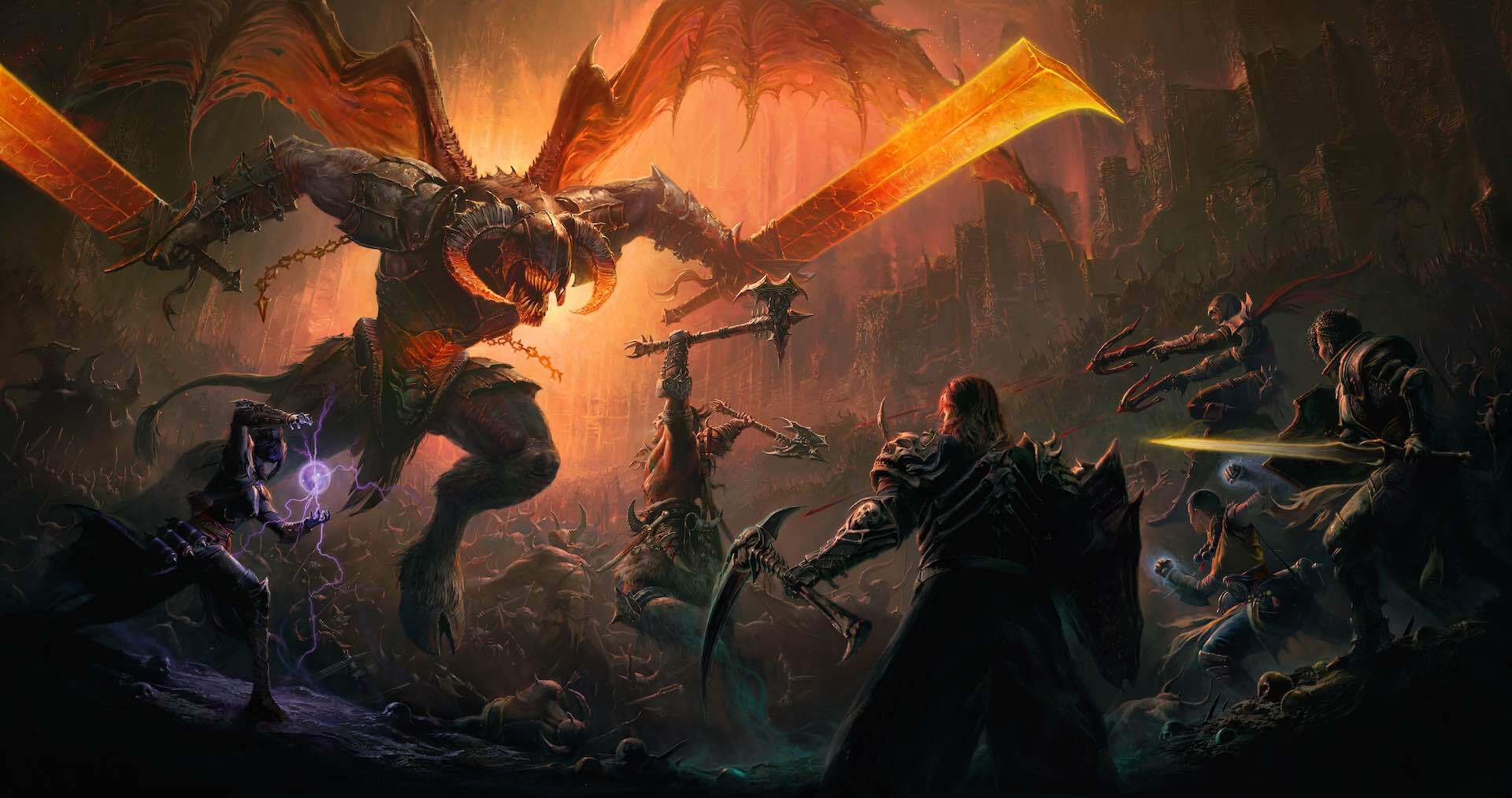There is little to question that Diablo Immortal is a big and richly produced Diablo entry. It looks great, it evolves the formula of action role-playing introduced in Diablo III and matches it acutely to the hardware it was originally designed for, and it strikes a good balance of making you feel powerful while also enticing you to continue hunting down better loot. In that sense, Diablo Immortal is just another good Diablo game, but it’s also one that can’t always be played with the same obsessive cadence as prior titles given the number of barriers that can routinely force some time away from it.
The story takes place between Diablo II and III, with familiar faces popping up to provide some thin context for events that have transpired by the time you arrive in Tristram at the start of the last core title. Deckard Cain is back (why wouldn’t he be?) and so is a new evil that is threatening to use shards of the same Worldstone to wreak havoc across the lands. Story conversations are fully voiced, which makes Immortal feel as premium as previous Diablo titles on PC. There’s really nothing here that suggests it’s anything less than that either, with large open spaces for you to explore and numerous side quests to undertake as you progress the story.
What is different is obviously where you’ll be playing. Diablo Immortal was designed for smartphones, and it’s unsurprising then that it plays best on them, too. The touch controls employ the familiar digital analog stick on the left side of the screen, while the right features a cluster of buttons for your various abilities. You have a single main attack along with four equippable skills to choose from, with a fifth ultimate ability button appearing once you have access to it. It’s simple and well-spaced out, and I never found myself accidentally pressing any skills I didn’t want to. You can move and have attacks target enemies automatically, which simplifies your focus further, but also helps you accurately aim certain skills that require it. With my Necromancer, I often need to choose the area in which I want to explode a bunch of corpses, which is easily done by just holding down the skill in question and rotating my finger to position it. In a chaotic fight where I needed to pull this off fast, the accuracy could be a little wonky, but these moments were mostly fleeting.
Diablo Immortal also supports a variety of controllers that you can pair using Bluetooth, and here the action becomes even more manageable. With a physical stick, movement is more natural and mapping abilities to buttons and triggers meant it was even rarer for mistakes to crop up. Better yet, the right stick can be used to aim abilities, removing the need to have a single tap perform double duty. Still, it wasn’t as significant a difference that I found myself always ensuring I had a controller on hand if I wanted to play Diablo Immortal on the go.
Diablo Immortal is also supported on PC, albeit under an “open beta” banner that is well-deserved. The game on PC is disappointing to say the least, missing many basic features expected of a PC game that make it a far worse way to play the game. While many of the game’s visual settings can still be toggled on and off from the mobile versions, including levels of detail and maximum frame rates, the PC version can only be played at 1080p. Though it’s still the most popular resolution amongst PC players, it’s unacceptable to have a PC version out that doesn’t let you change this setting, making UI elements and text look blown out and blurry at anything other than its native resolution. It’s clear, at this time at least, that Diablo Immortal was developed primarily for mobile, and thus you should probably stick to playing it there.
Gameplay has been tweaked to accommodate the move to mobile, too, simplifying the formula from Diablo III even further. No matter which of the five classes you pick, Immortal won’t burden you with managing mana or stamina to use abilities, instead just relying on cooldowns to balance things out. Each ability also only has a single upgrade path, removing the options that Diablo III gave you to change up their effects. This ultimately gives you a lot less to worry about, but also fewer options to tweak your build using just your abilities alone. Legendary gems that you start acquiring later in the game do augment existing abilities while completely changing others, giving you some flexibility that will be required if you aim to challenge the game’s more grueling content once you’ve hit its level cap of 60.
Initially, the story itself provides enough momentum to carry you through your movement between Diablo Immortal’s several hub areas, each of which has a level associated with it to describe its challenge. The structure of how you move between these areas differs slightly from the stringent act-based progression of previous games, but it ties in well with the more MMO-like nature of gameplay. After the brief introduction, your world is populated by a host of other players, letting you tackle dynamic events and bounties together. Other players will seamlessly join and leave your screen space as they see fit, not requiring you to actively party up in order to work towards the same objective (although the ability to do so does exist). You can complete Diablo Immortal’s story entirely alone if you wish, with only endgame activities requiring you to start finding a large group of players to raid with.
Each story act is usually bookended by a dungeon, which can be completed alone or with up to three other players via matchmaking. These are packed with creatures to kill and climactic boss battles that are a visual spectacle, while also providing significant loot rewards on completion. This mission can be replayed infinitely with higher difficulty modifiers to increase both the challenge and reward, while also providing a good amount of experience to supplement traditional progression. These, along with daily bounties, codex missions, and other side missions, are somewhat required after level 30 when core story progression grinds to a halt. Missions start requiring you to be a certain level to play them, while later game areas will have monsters far beyond your capabilities should you venture to them without the requisite gear and offensive power.

These small roadblocks will remind you Diablo Immortal is still a free-to-play mobile game, and its structure has been designed around the idea of frequent daily check-ins instead of instantly gratifying long play sessions. It enforces a grind that prevents you from continuing on with the story if that’s your primary focus, pushing you towards completing daily bounties, a variety of side missions buried in an assortment of menus that are specific to both your character and each of the areas you visit, as well as progression smaller side stories. None of these are as engaging as the main campaign, especially when most boil down to traveling to previous locations and killing a number of enemies you’ve already killed hundreds of. The paid version of the battle pass offers more experience bonuses if you choose to purchase it, which would speed this process up significantly, so the temptation to pay to bypass the roteness always feels present when you’re booting up the game and being reminded of the tasks that await. Still, if you’re adamant not to spend a cent, these hindrances might only delay your progress by a day at most, allowing you to grab new bounties and their associated rewards in order to progress.
Where Diablo Immortal’s microtransactions start becoming more troublesome is in its late-game content, and especially so once you’ve seen out the main story. Progression slows significantly from here, which impacts your ability to continue to subsequent playthroughs and increases your endgame paragon level. PvP play is also heavily reliant on some of the best gear and stat-altering gems that the game has to offer, the latter of which can be purchased through a marketplace that accepts an in-game currency that you can buy with real-world money (unlike Diablo III’s original Auction House, however, sales cannot be converted back to real money).
Random loot boxes work into the equation too, although Diablo Immortal eschews the actual mechanics of this into something slightly more interactive. Elder Rifts, like those introduced with Diablo III: Reaper of Souls, generate random dungeons with enemies and a boss for a brief, enjoyable loot rush. Immortal changes this formula slightly with crests, of which different types let you ensure the base rarity of items you’ll be rewarded with. In a way, Elder Rifts are Immortal’s form of loot boxes, with the odds of good loot depending on how many crests you’re willing to burn on each run.
Crests can be earned through play, but later start becoming scarcer. You can purchase two regular crests a day using in-game gold that you earn through play, but only one legendary crest a month through the same process. It’s the legendary crests that are most valuable, however, ensuring that you’ll receive a new Legendary Gem during a rift one, while regular crests are only assured to drop Runes (which help you craft these same gems). These Legendary Gems act as modifiers to your core abilities, making them stronger or changing their effects entirely in some cases. While offering more flexibility in your builds, they’re also crucial to endgame play, especially if you’re planning to get invested in PvP. If you’re looking to play beyond the story and increase your paragon level, Legendary Gems are some of the only ways to empower your character sufficiently, too, placing a reliance on them that makes traditional grinding feel increasingly slow when chasing them. It’s clear from this balance that players choosing to pay for more crests or those purchasing them off the in-game marketplace are at an advantage, as you’ll not be able to keep up otherwise.
Late-game loot progression, legendary gems, and Elder Rift runs all matter if you’re planning to play Diablo Immortal for a long time and invest in its incoming seasons and paragon progression. And you might be tempted to stick around, given how enjoyable the core campaign is. It’s a classic Diablo experience, letting you gleefully watch all your stats increase as hordes of monsters melt in front of you. The power trip it enables sits up there with some of the best the series has to offer, which makes the sudden halt in pace jarring and off-putting. But it’s still one that you can enjoy without needing to dive into the mess of menus and lists asking you to tap a button to claim a myriad of rewards day in and day out, given you’re comfortable with not being able to power through it all in just a handful of sittings.






